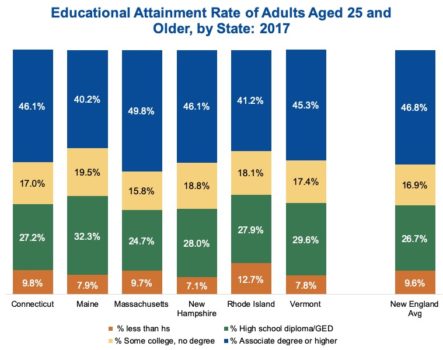The population of students pursuing postsecondary education in New England is not what it used to be. Fewer individuals fit the traditional profile of the 18- to 24-year old student who lives on campus and attends class full-time. Increasingly, adults are seeking higher education. These students include those who:
- Are aged 25 or older (who account for 33% of the New England postsecondary population)
- Are employed (64%)
- Are financially independent (49%)
- Have non-spousal dependents (24%)
- Have prior military experience (6%).

Despite these changes in the student population, approximately 5.5 million New Englanders between ages 25 and 64 still do not have a postsecondary degree (associate or higher). This group of adults represents an “untapped workforce” upon which the vitality of the region’s economy depends.
On September 26, the New England Board of Higher Education’s (NEBHE) Legislative Advisory Committee convened national experts in Woodstock, Vt., to explore effective strategies for (re-)engaging adult learners across the region. Enhancing access and services for adult learners is one of four critical priorities adopted by the NEBHE Board of Delegates in spring 2019.
Expert presenters from across the U.S. reflected on the current state of the adult learner space: Goldie Blumenstyk, senior writer at The Chronicle of Higher Education and national expert on the adult learner, Josh Garrison, associate commissioner for legislation and program implementation at Indiana’s Commission for Higher Education, and Emily House, deputy executive director at the Tennessee Higher Education Commission. Indiana and Tennessee have proven to be leaders in the adult learner space with their successful state initiatives: Next Level Jobs Indiana and Tennessee Reconnect. Here are five takeaways from their presentations:
1. Age is not the best way to define the nontraditional student.
A more accurate definition of these students centers on their financial independence, commitments to family and work, and a personal identity “that is not predominantly anchored in the role of the college student.” For instance, Tennessee re-evaluated its understanding of the adult learner: they are workers who learn, not learners who work.
2. Traditional higher education practices need to be reformed for the nontraditional student.
Policymakers and institution leaders will need to rethink many established postsecondary practices to accommodate the needs of nontraditional students. State financial aid deadlines should be extended, since adults enroll in different patterns than traditional students. In many cases, adults seeking to return to college ought to be granted “academic forgiveness”—that is, a 35-year-old seeking to increase their skills should not be prevented from doing so because of their poor academic performance at age 19. Likewise, debt-forgiveness ought to be considered; many individuals cannot re-enroll in college or retrieve their transcript due to debt. Lastly, institutions need to be incentivized to develop systems for accessing prior learning and accept credits for that experience.
3. We need to get to know the adult learner better.
Most higher education decision-makers are fortunate: They did not fail higher education, and higher education did not fail them. Yet, for many adults who dropped out or who chose not to attend college at all, their experience is quite different. First and foremost, the data need to be disaggregated so that we can understand who comprises the true adult population. For instance, Virginia’s model Nudge for Success Lab is dedicated to building “public agencies’ capacity to apply data and behavioral science strategies to help people pursue tailored pathways to educational and economic success.” Once we have a better picture of the adult population, states should consider holding focus groups to meet face-to-face with the individuals who stand to be most affected by adult-oriented policies. Both Indiana and Tennessee held focus groups with adults, from which they gained firsthand insight into the barriers and motivators individuals face when they consider returning to higher education. In Indiana, the focus groups revealed that the single biggest motivator for their state’s returning adults was their desire to prove to their children that they could get a college degree.
4. Keep marketing simple.
It’s no secret that adults are busy and have multiple time commitments. States and institutions need to make sure that returning to college does not pose an additional insurmountable time commitment. Adults should be able to navigate systems easily and quickly. Marketing material needs to be deliberate and clear, and websites need to be “easy enough for your grandma to navigate,” according to Josh Garrison. In marketing materials, Emily House states that institution neutrality is also important. Many individuals who dropped out of college have a bad taste in their mouths about their former institution. Promotional materials should be free of specific school logos and should avoid language that points to a specific institution or set of institutions.
5. Human connection is crucial.
Many returning adults need assistance navigating their college experience. The most effective way to provide this help is not through automated call systems or online FAQ pages, but through communication with another actual human being. As part of Tennessee’s adult learner initiative, Tennessee Reconnect, the state engages a group of volunteer ambassadors who assist returning adults by answering questions related to higher education, as well as other state programs, such as SNAP. These volunteers are not experts, but merely community-oriented, low-touch individuals willing to offer guidance to inexperienced adults seeking to pursue a college degree.
Click to access a New England Adult Learner Fact Sheet
Stephanie M. Murphy is a policy & research analyst at NEBHE.
[ssba]
